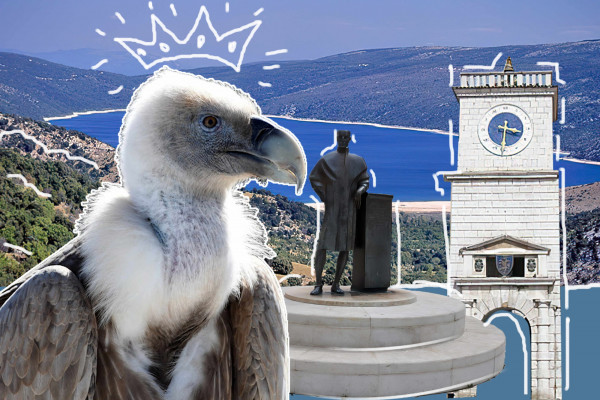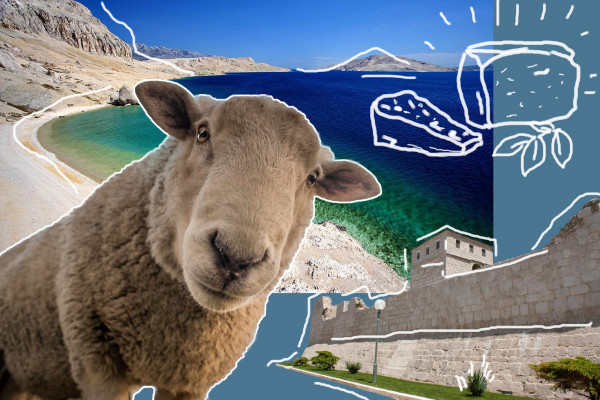Show all photos
Spiritual Journey Through Dubrovnik and its Surroundings
The city of Dubrovnik and its surroundings preserve numerous sacral buildings that tell stories about the spiritual life of this area through the centuries. From the Illyrian sanctuary and one of the oldest synagogues in Europe, all the way to the magnificent stone cathedrals - there is really an abundance of special places.
If you have decided to visit the holy places on your vacation in the south of Croatia, read below which places you should not miss.
1. Dubrovnik Cathedral - Dubrovnik Cathedral is dedicated to the Assumption of the Blessed Virgin Mary and is located on the site of an older cathedral that was destroyed in a great earthquake in the 17th century. Today's magnificent Baroque cathedral was built from 1671 to 1713. The cathedral's treasury houses many gold and silver reliquaries, crosses, church utensils and paintings by Italian, Flemish and Croatian painters, including "Virgin Mary with Child" from the 16th century by the famous painter Raphael. In the treasury there is also a relic of the head of St. Vlach from the 11-12th century. It is decorated with enamel medallions and precious stones made by famous Dubrovnik goldsmiths.
2. Franciscan Monastery in Dubrovnik - The Franciscan monastery was built in the 14th century. Today, its many visitors enjoy the rich treasury of paintings, the music archive, the famous library, various gold and silver works of art located in the monastery. There is also the oldest pharmacy in Europe (1317) along with its inventory.
3. Church of St. Blaise - This most famous church in Dubrovnik was built in honor of the patron saint of the city of Dubrovnik - St. Blaise, who, according to legend, informed the Senate of the Venetians' intention to attack the city and prepare the people of Dubrovnik for defense.
4. Serbian Orthodox Church in Dubrovnik - The Serbian Orthodox Church of the Holy Annunciation was built in Dubrovnik's old town in the 19th century, on the ancient ruins of the old palaces of Dubrovnik nobles. Today next to it is the Museum with valuable icons and the center of the Serbian Orthodox Church Municipality of Dubrovnik.
5. Synagogue in Dubrovnik - Dubrovnik Synagogue is one of the oldest in Europe and dates back to 1652. It was built in one of the baroque houses within the city walls. In the synagogue today you can see various religious exhibits, archival documents and Torah dating from the 13th to the 17th century. With its lavishly decorated interior, it leaves no one indifferent. In addition to the Synagogue, the Jewish community in Dubrovnik has its own cemetery on Boninovo and a small Jewish fountain on Pile.
6. Benedictine monastery of St. Mary on the island of Lokrum - Benedictine monastery of St. Mary on the island of Lokrum is the oldest and most important Benedictine abbey in the Dubrovnik area, which was founded in the 11th century. The 15th and 16th centuries were a period of architectural prosperity. The Benedictines then built a representative Gothic-Renaissance monastery, which was significantly damaged in the great earthquake of 1667. With the abolition of the abbey at the end of the 18th century, the Benedictines left the island and Lokrum became the property of the powerful Austro-Hungarian Habsburg dynasty, which turned the monastery into its country residence and first-class architectural monument in Croatia.
7. Nakovana Fortress on the Peljesac Peninsula - According to archeological research, the town of Nakovana on the Peljesac Peninsula has been inhabited for at least 8000 years, which makes it one of the oldest places with a continuous life of humans. During antiquity, Nakovana was ruled by the Illyrians, whose center was on the hill Grad. This natural fortress was additionally fortified with strong walls and ramparts. The Illyrian treasure, however, was found by archaeologists in 2001 in Spila, where they found a long-forgotten Illyrian fertility shrine in a well-hidden hall. The place still attracts many interested visitors.
8. Monastery of Our Lady of the Angels in Orebic - The monastery was built at the end of the 16th century under the Republic of Dubrovnik. It was built by the Franciscans and has a distinctive Gothic-Renaissance style. It is surrounded by a dense and fragrant pine forest, and is located on a rocky ridge as high as 152 meters above sea level. The monastery offers a panoramic view to the east, south and west over the Korcula and Peljesac sea canals with the old town of Korcula in the background. Sailors passing under the monastery would traditionally greet it with three invitations to their ship’s sirens, and then the Franciscans would answer with their church bells. The sound of church bells could be heard throughout the sea channel.
9. Church of St. Nicholas in Trpanj - Church of St. Nicholas is located on one of the Trpanj hills, which offers a beautiful view of the whole village, the coast and the island of Hvar. The church was built by the sailor Klement Cvitanovic in 1840 as a vow. It is written on the church fence "covered by white waves, he was freed from death". Inside there is an altar with a picture of St. Nicholas and St. Liborius of Le Mans. It is connected by stairs to the highest hill, where the church of St. Rocco is.
10. St. Mark's Cathedral in the town of Korcula - One of the most famous sights of the island of Korcula is St. Mark's Cathedral was built in the 15th century, in the Gothic-Renaissance style. Located on the main town square it is almost impossible to avoid it when you are on this beautiful island. It is adorned with a beautiful Romanesque portal made by the sculptor and architect Bonino from Milan.
Itinerary
Place 1
Dubrovnik Cathedral
Place 1
Dubrovnik Cathedral
Dubrovnik Cathedral is dedicated to the Assumption of the Blessed Virgin Mary and is located on the site of an older cathedral that was destroyed in a great earthquake in the 17th century. Today's magnificent Baroque cathedral was built from 1671 to 1713. The cathedral's treasury houses many gold and silver reliquaries, crosses, church utensils and paintings by Italian, Flemish and Croatian painters, including "Virgin Mary with Child" from the 16th century by the famous painter Raphael. In the treasury there is also a relic of the head of St. Vlach from the 11-12th century. It is decorated with enamel medallions and precious stones made by famous Dubrovnik goldsmiths
Place 2
Franciscan Monastery in Dubrovnik
Place 2
Franciscan Monastery in Dubrovnik
The Franciscan monastery was built in the 14th century. Today, its many visitors enjoy the rich treasury of paintings, the music archive, the famous library, various gold and silver works of art located in the monastery. There is also the oldest pharmacy in Europe (1317) along with its inventory
Place 4
Serbian Orthodox Church in Dubrovnik
Place 4
Serbian Orthodox Church in Dubrovnik
The Serbian Orthodox Church of the Holy Annunciation was built in Dubrovnik's old town in the 19th century, on the ancient ruins of the old palaces of Dubrovnik nobles. Today next to it is the Museum with valuable icons and the center of the Serbian Orthodox Church Municipality of Dubrovnik
Place 5
Synagogue in Dubrovnik
Place 5
Synagogue in Dubrovnik
Dubrovnik Synagogue is one of the oldest in Europe and dates back to 1652. It was built in one of the baroque houses within the city walls. In the synagogue today you can see various religious exhibits, archival documents and Torah dating from the 13th to the 17th century. With its lavishly decorated interior, it leaves no one indifferent. In addition to the Synagogue, the Jewish community in Dubrovnik has its own cemetery on Boninovo and a small Jewish fountain on Pile.
Place 6
Benedictine monastery of St. Mary on the island of Lokrum
Place 6
Benedictine monastery of St. Mary on the island of Lokrum
Benedictine monastery of St. Mary on the island of Lokrum is the oldest and most important Benedictine abbey in the Dubrovnik area, which was founded in the 11th century. The 15th and 16th centuries were a period of architectural prosperity. The Benedictines then built a representative Gothic-Renaissance monastery, which was significantly damaged in the great earthquake of 1667. With the abolition of the abbey at the end of the 18th century, the Benedictines left the island and Lokrum became the property of the powerful Austro-Hungarian Habsburg dynasty, which turned the monastery into its country residence and first-class architectural monument in Croatia.
Place 7
Nakovana Fortress on the Peljesac Peninsula
Place 7
Nakovana Fortress on the Peljesac Peninsula
According to archeological research, the town of Nakovana on the Peljesac Peninsula has been inhabited for at least 8000 years, which makes it one of the oldest places with a continuous life of humans. During antiquity, Nakovana was ruled by the Illyrians, whose center was on the hill Grad. This natural fortress was additionally fortified with strong walls and ramparts. The Illyrian treasure, however, was found by archaeologists in 2001 in Spila, where they found a long-forgotten Illyrian fertility shrine in a well-hidden hall. The place still attracts many interested visitors.
Place 8
Monastery of Our Lady of the Angels in Orebic
Place 8
Monastery of Our Lady of the Angels in Orebic
The monastery was built at the end of the 16th century under the Republic of Dubrovnik. It was built by the Franciscans and has a distinctive Gothic-Renaissance style. It is surrounded by a dense and fragrant pine forest, and is located on a rocky ridge as high as 152 meters above sea level. The monastery offers a panoramic view to the east, south and west over the Korcula and Peljesac sea canals with the old town of Korcula in the background. Sailors passing under the monastery would traditionally greet it with three invitations to their ship’s sirens, and then the Franciscans would answer with their church bells. The sound of church bells could be heard throughout the sea channel.
Place 10
St. Mark's Cathedral in the town of Korcula
Place 10
St. Mark's Cathedral in the town of Korcula
One of the most famous sights of the island of Korcula is St. Mark's Cathedral was built in the 15th century, in the Gothic-Renaissance style. Located on the main town square it is almost impossible to avoid it when you are on this beautiful island. It is adorned with a beautiful Romanesque portal made by the sculptor and architect Bonino from Milan.













